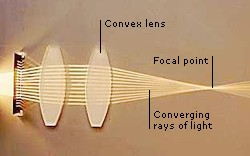DK Science & Technology: Lenses
When you look through a magnifying glass, or take a picture with a camera, you are using a lens. A lens is a polished piece of glass or transparent plastic with curved surfaces. There are two main shapes of lenses, CONVEX and CONCAVE.
A lens changes the direction of light waves by refraction. It may form an image of a scene or an object. The image might be smaller (as in a camera), or larger (as in a microscope). Because a lens is curved, light rays strike different parts of its surface and are bent by different amounts. Depending on the lens shape, a beam of light either diverges (spreads out) or converges (concentrates).
A microscope makes a tiny, nearby object look much bigger. A telescope makes a large, distant object or scene appear much closer and brighter. In both instruments, light from the object passes through two or more lenses to form an image. The shapes of the lenses and the distances between them alter the image that is produced.
This type of lens is thicker in the center than at the edge. Parallel rays of light entering it on one side will converge (meet) at a particular spot on the other side of the lens. Magnifying glasses and microscopes use convex lenses.
A magnifying glass makes an object look bigger. Holding it close to an object makes a virtual image of the object form on the same side of the glass as the object. When you look through the magnifying glass, this virtual object seems to be larger than the real one. The thicker the lens, the larger the virtual image.
A concave lens is thinner at the center than at the edge. Parallel light rays passing into one side of the lens diverge (spread out) as they emerge from the other side.
If you are nearsighted, your eye lens focuses a scene just in front of the retina in your eye and the image you see is blurred. A concave lens spreads out the light rays before they enter the eye, so that they are focused on the retina and the image is sharp.


